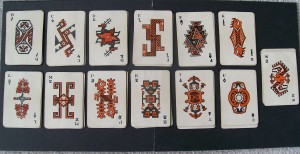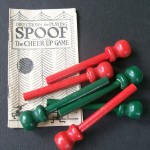Based on symbols of the Inca Indians, the designs found on the cards in the 1918 game of Spoof show fascinating examples of early Peruvian art.

Milton Bradley published a competitive, fast-paced card game called Spoof in 1918. Written in the directions for playing the game is an explanation for why the game was named Spoof and the origins of the lively game. It is revealed that Spoof was the name given to any Incan tribe member who consistently came up short with his share for desired goods. The game of Spoof applies the same principal. A player who consistently comes up short in the game will also be given the name of Spoof.
According to the directions, once five marks (symbolizing a member’s inadequacy) were placed beside a member’s name in the tribe’s record books, he became the tribe’s Spoof. The ancient custom of the Incas required this individual to then be in service of the entire tribe. He was forced to perform tasks wanted done by others until another member replaced him as the Spoof.
Playing the game of Spoof follows and demonstrates this Inca’s practice. If a player is not alert or swift as others, he will be named Spoof and may be required to perform some ridiculous task or action for the other players. This teaches or creates the incentive to be as vigilant as possible so as not to become the game’s Spoof; just like the old custom.
The game includes 52 wonderfully illustrated cards and 6 brightly colored batons. The cards display 13 different designs. These images (4 of each) keep with the artwork and symbols which were drawn and used by the Inca’s and offers a unique glance into the amazing empire.

The rules for playing the game are as follows:
Depending on how many players are playing the game determines the amount of cards and batons used. If there are four players, then only forty cards are used out of the 52 (take out 3 designs for a total of 12 cards from the deck). For a five or six player game, all cards are used. The cards are dealt one by one to each player. In a four player game, the cards are evenly dealt with each player receiving 10 cards. However, in a five and six player game, some players will have one more card than some others. These ‘extra’ cards do not affect game play at all.

The batons are placed in the center of the table so each player is able to reach them. The number of batons placed in the center is one less than the number of players. For example, if six players are playing, then only five batons are used.
The object of the game is to get a matching set of four cards and/or grab a baton. Once all cards are dealt, players begin by passing unwanted cards (facedown) from their hand to their left. Since players sit in a circle, they will receive cards from their right. As fast as possible, players race to keep cards which they feel may help make a set of four in their hand and discard others which won’t. Upon getting four of a kind, the player quietly places his set down in front of him and grabs a baton from the center pile.
Once the first player gets a set of four and grabs a baton, all other players race to grab the remaining batons. Since the number of batons are one less than players, there is one player left without. This player has come up short and receives a mark against his name. For the round he receives a letter S.
Another round then begins. Play is the same. After each round is finished a letter is placed beside the name of the player who was not able to grab a baton. If five letters, spelling SPOOF, are written beside a player’s name, he is then called the Spoof and the game ends.
This method of play is highly aggressive and engagingly fun. The fast action of passing the cards and grabbing the batons has players laughing during the chaos. For this reason it can be understood why Milton Bradley also called Spoof, the Cheer-up Game. Any players involved in the amusing scuffles are certainly going to find themselves having a great time and be ‘cheered-up’.

Pingback: Ten Best Camping Games to Play | All About Fun and Games